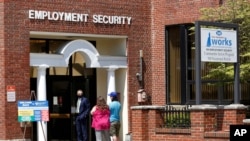New claims for jobless benefits in the U.S. dropped again last week, the Labor Department reported Thursday, as the world’s biggest economy continues its steady but uneven recovery from the coronavirus pandemic.
A total of 444,000 out-of-work employees filed for unemployment compensation, down 34,000 from the revised figure of the week before, the agency said. The figure was the lowest total since mid-March 2020 when the pandemic first swept into the country, although still more than twice the pre-coronavirus weekly average of 218,000 in 2019.
About 48% of U.S. adults have now been fully vaccinated against the coronavirus, boosting the economic recovery, although the pace of inoculations has dropped from its peak a few weeks ago.
The continuing drop in the number of jobless benefit claims could presage more hiring, but U.S. employers only added 266,000 more jobs in April, down from the robust 916,000 figure in March. Nearly 10 million people remain unemployed in the U.S.
With the uneven recovery, many employers are reporting a shortage of workers, particularly for low-wage jobs, such as restaurant servers and retail clerks.
The federal government approved sending $300-a-week supplemental unemployment benefits to jobless workers through early September on top of less generous state-by-state payments. But at least 21 of the 50 states, all led by Republican governors, are now ending participation in the federal payments sooner, contending that the stipends let workers make more money than they would by returning to work and thus are hurting the recovery by not filling available job openings.
As the overall number of vaccinations increases, more Americans are re-engaging in public, going out to eat, traveling and spending on consumer goods they had stopped buying during the worst of the pandemic, spending partly fueled by government assistance sent to all but the biggest wage earners.
Even as health experts continue to urge caution about the coronavirus, federal health officials say those who are fully vaccinated no longer need to wear masks in most settings. Numerous state governors are revoking their mask-wearing orders and allowing businesses to fully reopen or setting dates in coming weeks when they say businesses can ramp up.
Still, crowds at most sporting events remain curtailed, at-home work is commonplace and the number of full school re-openings with in-class instruction is spotty throughout the country, although most school districts are promising to fully reopen in August and September.
The employment picture in the U.S. has been boosted as money from President Joe Biden’s $1.9 trillion coronavirus relief package filters through the economy. The measure could add to hiring and consumer spending, as millions of Americans, all but the highest wage earners, are now receiving $1,400 stimulus checks from the government or have already been sent the extra cash.
Biden has proposed an additional $4 trillion in government spending on infrastructure repairs and assistance for children and families, but the fate of the proposals in a politically divided Congress is uncertain.
Numerous Republican lawmakers have voiced opposition to the size of the Democratic president’s spending plans and his proposals to pay for them with higher taxes on the wealthiest Americans.
The number of vaccinations against the coronavirus has now also dropped to about 2 million a day, down from more than 3 million daily a few weeks ago. Some people remain skeptical about getting a shot, which in turn could limit the country’s overall economic recovery. All adults in the U.S. are eligible to get a shot if they want one, with teenagers now being inoculated, too.
More than 125 million Americans are fully inoculated with one of three available vaccines.








